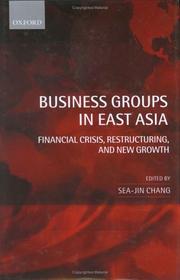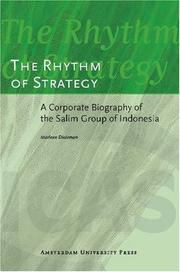| Listing 1 - 8 of 8 |
Sort by
|

ISBN: 0191536954 1423757335 1281154512 9786611154516 9780191536953 9780199287345 0199287341 Year: 2006 Publisher: Oxford : Oxford University Press,
Abstract | Keywords | Export | Availability | Bookmark
 Loading...
Loading...Choose an application
- Reference Manager
- EndNote
- RefWorks (Direct export to RefWorks)
The 1997 Asian Crisis principally affected Thailand, Indonesia, Malaysia, and Korea, as well as other East Asian countries heavily dependent on intra-regional trade. Banks and other financial institutions quickly become insolvent, and heavily indebted industrial firms went bankrupt. Many of these firms were affiliated with the business groups of this region, yet most groups did not immediately collapse, indeed they proved remarkably robust, some surviving and even prospering.This book examines these East Asian business groups and their subsequent restructuring following the Asian Crisis. East
Conglomerate corporations --- Financial crises --- East Asia --- Economic conditions --- Chaebols --- Conglomerate mergers --- Conglomerates (Corporations) --- Corporations, Conglomerate --- Keiretsu --- Mergers, Conglomerate --- Asia, East --- Asia, Eastern --- East (Far East) --- Eastern Asia --- Far East --- Consolidation and merger of corporations --- Corporations --- Industrial concentration --- Competition --- Orient
Book
ISBN: 3658026766 3658026774 Year: 2014 Publisher: Wiesbaden : Springer Fachmedien Wiesbaden : Imprint: Springer Gabler,
Abstract | Keywords | Export | Availability | Bookmark
 Loading...
Loading...Choose an application
- Reference Manager
- EndNote
- RefWorks (Direct export to RefWorks)
The decision to diversify lies at the core of corporate strategy and constitutes one of top management’s most important choices. Yet despite its importance and prominence within academic research, diversification remains subject to ongoing debate. Matthias Knecht introduces a new perspective on corporate diversification that extends the academic discussion and reveals substantial new insights. The author introduces the dynamism of industries as a dominant force in the environment that influences the diversified corporation on multiple levels. Due to similarities of businesses competing in similarly dynamic environments, synergistic benefits and superior economic performance can be realized through the combination of dynamic-related businesses in the corporate portfolio. This study provides a multidimensional operationalization of industry dynamism and an in-depth assessment of the dynamism of a wide range of industries. At the core of the study Knecht investigates the performance impact of dynamic-related diversification strategies. The results provide new insights into successful corporate portfolio construction in the face of today’s dynamic environments. Contents n Corporate Diversification Strategies n Measurement of Industry Dynamism n Impact of Dynamism on the Multi-business Firm Target Groups ● Scholars and students from the strategic management and finance disciplines ● Corporate top managers interested in the performance effects of corporate diversification strategies About the Author Dr. Matthias Knecht obtained his doctorate degree at Friedrich-Alexander University Erlangen-Nürnberg. He works as a strategy consultant. .
Business. --- Conglomerate corporations. --- Strategic planning. --- Commerce --- Business & Economics --- Marketing & Sales --- Economic Theory --- Diversification in industry. --- Chaebols --- Conglomerate mergers --- Conglomerates (Corporations) --- Corporations, Conglomerate --- Keiretsu --- Mergers, Conglomerate --- Industrial diversification --- Product diversification --- Industrial organization. --- Economics. --- Industrial Organization. --- Consolidation and merger of corporations --- Corporations --- Industrial concentration --- Competition --- Input-output analysis --- Barriers to entry (Industrial organization) --- Multiproduct firms --- Industries --- Organization --- Industrial management --- Industrial sociology
Book
ISBN: 2355960186 6167571287 Year: 2018 Publisher: Bangkok : Institut de recherche sur l’Asie du Sud-Est contemporaine,
Abstract | Keywords | Export | Availability | Bookmark
 Loading...
Loading...Choose an application
- Reference Manager
- EndNote
- RefWorks (Direct export to RefWorks)
Les échanges de produits alimentaires du XXIe siècle voient poindre l’émergence de nouveaux acteurs de taille globale originaires d’Asie du Sud-Est. Il s’agit de grandes entreprises privées extrêmement diversifiées qui sont apparues dans un système de connivence avec les pouvoirs publics des États issus de la décolonisation. Cette étude vise à dégager quelques similitudes dans la genèse et le développement de cinq de ces grands groupes particulièrement emblématiques, à savoir Charoen Pokphand (CP) pour la Thaïlande, Indofood en Indonésie (Groupe Salim), San Miguel aux Philippines, Sime Darby pour la Malaisie et Wilmar pour Singapour (Groupe Kuok). Ces convergences concernent les stratégies mises en œuvre par ces conglomérats mais aussi quelques aspects de leur mode de gouvernance, qui privilégie l’opportunisme avec une valorisation pragmatique de leurs ressources plutôt qu’une conceptualisation passant par des objectifs qui viseraient à satisfaire une demande particulière. Si l’avenir de ces acteurs est loin d’être limpide, ils sont désormais incontournables dans leurs secteurs d’activité au sein desquels ils figurent parmi les leaders mondiaux. Leur originalité qui se caractérise par une grande flexibilité, une redoutable efficience et une indéniable résilience contribue à relativiser des modèles entrepreneuriaux euro-centrés qui ne feraient que reproduire ceux du XIXe ou XXe siècle.
Economics --- Business --- Asie du Sud-Est --- agroalimentaire --- agriculture --- santé --- conglomérats --- agro-industriel --- entrepreneurs --- sécurité alimentaire --- alimentation --- Thaïlande --- Vietnam --- Malaisie --- Indonésie --- Philippines --- Cambodge --- monopole --- économie --- Asean --- Southeast Asia --- industry --- agroindustry --- health --- conglomerates --- firms --- capitalism --- food --- food security --- Thailand --- Viet Nam --- Malaysia --- Indonesia --- Cambodia --- monopoly --- economics

ISBN: 1107133742 1280161299 1139148168 0511120575 051106490X 0511058578 0511331193 0511510861 0511073364 9780511120572 9780511064906 9780511073366 9781280161292 9786610161294 6610161291 9780521814355 0521814359 0521814359 9781139148160 9780511058578 9780511331190 9780511510861 9780521025195 0521025192 Year: 2003 Publisher: Cambridge : Cambridge University Press,
Abstract | Keywords | Export | Availability | Bookmark
 Loading...
Loading...Choose an application
- Reference Manager
- EndNote
- RefWorks (Direct export to RefWorks)
Sea-Jin Chang argues that the Korean financial crisis of 1997 was due to the inertia of both the business groups known as chaebols and the Korean government which prevented adaptation to changing external environments. Once the Korean government stopped central economic planning and pursued economic liberalization in the 1980s, the transition created a void under which neither the government nor markets could monitor chaebols' investment activities. The intricate web of cross-shareholding, debt guarantees, and vertical integration resulted in extensive cross-subsidization and kept chaebols from shedding unprofitable businesses. The government's continued interventions in banks' lending practices created 'moral hazards' for both chaebols and banks. This treatment demonstrates how the structure of chaebols later inhibited other adaptations and for all practical purposes became nearly dysfunctional. The book argues that restructuring of chaebols should focus on improving corporate governance systems. After such restructuring, the author predicts, chaebols will re-emerge as stronger, more focused global players.
Corporations --- Conglomerate corporations --- Financial crises --- Corporate governance --- Finance. --- K9400.80 --- K9411 --- K9415 --- K9480 --- Finance --- Korea: Economy and industry -- history -- modern period, postwar period (1945- ) --- Korea: Economy and industry -- organization and systems -- conglomerates, Chaebŏl --- Korea: Economy and industry -- business methods and management --- Korea: Economy and industry -- finance industries --- Business, Economy and Management --- Economics

ISBN: 9053560335 9786611191139 1281191132 9048501040 9789048501045 9789053560334 9781281191137 Year: 2007 Publisher: [Amsterdam] : Amsterdam University Press,
Abstract | Keywords | Export | Availability | Bookmark
 Loading...
Loading...Choose an application
- Reference Manager
- EndNote
- RefWorks (Direct export to RefWorks)
The Rhythm of Strategy provides a richly documented analysis of the Salim Group, one of the largest family conglomerates in Southeast Asia. Set up by Liem Sioe Liong, a Chinese emigrant, the Salim Group evolved from a small trading venture in colonial Java into one of the largest diversified businesses on the Asian continent. While the Salim Group is generally reluctant to provide information on its strategy to the general public, this volume proposes that the conglomerate's strategy oscillates between a business model built on connections and a professional model adapted to markets. Dismissing the view that the group is a typical Chinese ethnic firm-in which the cultural values of the founding family influences corporate behavior-The Rhythm of Strategy argues that the group's strategy made sense in the evolving institutional context of Indonesia, which is characterized by high transaction costs, corruption, political risk, and ample business opportunities to cater to a large and rapidly growing consumer base.
Chinese -- Indonesia. --- Conglomerate corporations -- Indonesia. --- Corporations, Chinese -- Indonesia. --- Family-owned business enterprises -- Indonesia. --- Salim group. --- Industrial Management --- Management --- Business & Economics --- Conglomerate corporations --- Family-owned business enterprises --- Chinese --- Corporations, Chinese --- Salim Group. --- Chinese corporations --- Business enterprises, Family-owned --- Family business --- Family businesses --- Family enterprises --- Family firms --- Chaebols --- Conglomerate mergers --- Conglomerates (Corporations) --- Corporations, Conglomerate --- Keiretsu --- Mergers, Conglomerate --- Business enterprises --- Consolidation and merger of corporations --- Corporations --- Industrial concentration --- Competition

ISBN: 963732612X 9786611376741 1281376744 1423717511 6155053669 9781423717515 9781281376749 Year: 2005 Publisher: New York, NY Central European University Press
Abstract | Keywords | Export | Availability | Bookmark
 Loading...
Loading...Choose an application
- Reference Manager
- EndNote
- RefWorks (Direct export to RefWorks)
Financial services industry has shown trends of increased consolidation across different types of financial institutions. This book focuses on the conglomeration of banking and insurance activities among financial institutions of the 15 old members of the European Union, and addresses the development and impact of conglomeration linkages between these fifteen and the ten new member states. Most of the large groups combining banking and insurance activities groups among the former member states of the European Union are often linked to the largest such institutions in the new member states, having created the linkages mainly through Merger & Acquisition Activities; with greater accent on the banking sector and lesser connections on insurance side. Financial conglomeration linkages between the EU-15 and the new member states highlight investment attractiveness of the new members, with the appeal of new markets that allow the presence of more participants. Both institution-specific and country-specific factors play role in conglomeration across the new member states.
POLITICAL SCIENCE --- Public Policy / Economic Policy --- EEC / European Union - EU -Europese Unie - Union Européenne - UE --- 333.102 --- Bankconcentratie. --- Financial services industry --- Conglomerate corporations --- Chaebols --- Conglomerate mergers --- Conglomerates (Corporations) --- Corporations, Conglomerate --- Keiretsu --- Mergers, Conglomerate --- Services, Financial --- Consolidation and merger of corporations --- Corporations --- Industrial concentration --- Competition --- Service industries --- Bankconcentratie --- Financial services industry. --- European Union countries. --- Conglomerate corporations. --- 21st century, Banks, Economic integration, European Union, Financial services, Late 20th century.
Book
ISBN: 0520968190 9780520968196 0520295439 9780520295438 2016056134 Year: 2017 Publisher: Oakland, California University of California Press
Abstract | Keywords | Export | Availability | Bookmark
 Loading...
Loading...Choose an application
- Reference Manager
- EndNote
- RefWorks (Direct export to RefWorks)
"The film industry in Hollywood now employs a global mode of production run by massive media conglomerates that mobilize hundreds, sometimes thousands, of workers for each feature film or television series. Yet these workers and their labor remain largely invisible to the general audience. In fact, this has been a signal characteristic of Hollywood style for more than a hundred years: everything that matters happens onscreen, not off. Consequently, when it comes to movies and television, the voices heard most often are those belonging to talent and corporate executives. Those we hear least are the voices of labor, and it's that silence we aim to redress in the collection of interviews in this book. Drawing from the detailed and personal accounts in this collection, we offer three interrelated propositions about the current state and future prospects of craftwork and screen media labor: 1. Craftwork exists within an intricate and intimate matrix of social relations. 2. Hollywood craftwork today constitutes a regime of excessive labor. 3. Screen media production is a protean entity. We organized the collection into three sections: company town, global machine, and fringe city. The first section refers to Hollywood's historic roots as a core component of the motion picture business. The second section engages more directly with the spatial dynamics of film and television production to underscore the economic and political structures that are integrating distant locations into the studios' mode of production. We close with a section on the visual effects sector, in which stories shared by vfx artists, advocates, and organizers specifically illustrate how the industry today relies on marginal institutions to sustain its power and profitability"--Provided by publisher.
Motion picture industry --- Mass media and globalization. --- Employees --- Globalization and mass media --- Globalization --- Film industry (Motion pictures) --- Moving-picture industry --- Cultural industries --- SOCIAL SCIENCE / Media Studies. --- artists. --- behind the scenes. --- blue collar. --- business. --- conglomerates. --- craftwork. --- feature film. --- film industry. --- historic roots. --- history. --- hollywood. --- interviews. --- media. --- motion picture. --- movies. --- personal accounts. --- power. --- production. --- profitability. --- screen media. --- social relations. --- studios. --- style. --- television series. --- tv. --- vfx. --- visual effects. --- workers.

ISBN: 0226532704 9786612537417 0226532720 1282537415 9780226532721 9780226532707 9781282537415 6612537418 Year: 2006 Publisher: Chicago : University of Chicago Press,
Abstract | Keywords | Export | Availability | Bookmark
 Loading...
Loading...Choose an application
- Reference Manager
- EndNote
- RefWorks (Direct export to RefWorks)
For Western economists and journalists, the most distinctive facet of the post-war Japanese business world has been the keiretsu, or the insular business alliances among powerful corporations. Within keiretsu groups, argue these observers, firms preferentially trade, lend money, take and receive technical and financial assistance, and cement their ties through cross-shareholding agreements. In The Fable of the Keiretsu, Yoshiro Miwa and J. Mark Ramseyer demonstrate that all this talk is really just urban legend. In their insightful analysis, the authors show that the very idea of the keiretsu was created and propagated by Marxist scholars in post-war Japan. Western scholars merely repatriated the legend to show the culturally contingent nature of modern economic analysis. Laying waste to the notion of keiretsu, the authors debunk several related "facts" as well: that Japanese firms maintain special arrangements with a "main bank," that firms are systematically poorly managed, and that the Japanese government guided post-war growth. In demolishing these long-held assumptions, they offer one of the few reliable chronicles of the realities of Japanese business.
Economic order --- Japan --- J4411 --- Japan: Economy and industry -- industrial organization and relations -- conglomerates, zaibatsu, keiretsu --- Conglomerate corporations - Japan. --- Conglomerate corporations -- Japan. --- Corporations - Finance. --- Corporations -- Finance. --- Japan -- Economic conditions -- 1989-. --- Japan - Economic conditions - 1989-. --- Japan -- Economic policy -- 1989-. --- Japan - Economic policy - 1989-. --- Industrial Management --- Management --- Business & Economics --- Economic policy --- Economic conditions --- Conglomerate corporations --- Corporations --- Finance. --- Business finance --- Capitalization (Finance) --- Corporate finance --- Corporate financial management --- Corporation finance --- Financial analysis of corporations --- Financial management, Corporate --- Financial management of corporations --- Financial planning of corporations --- Managerial finance --- Going public (Securities) --- Finance --- E-books --- keiretsu, business, japan, economy, alliance, corporation, preference, trading, shareholding, lending, marxism, conglomerate, main bank, management, growth, economics, zaibatsu, outside directors, government, regulation, assistance, loyalty, honor, market, central planning, myth, urban legend, profit, industrial policy, networks.
| Listing 1 - 8 of 8 |
Sort by
|

 Search
Search Feedback
Feedback About
About Help
Help News
News